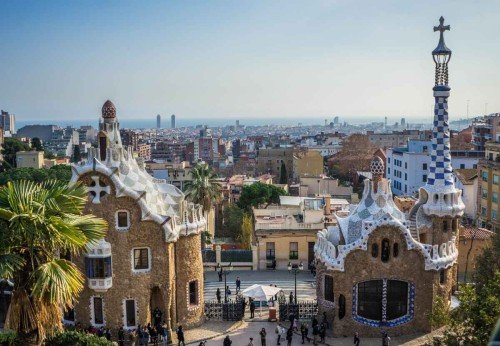
Antoni Gaudi (1852-1926) was a renowned Spanish architect who is widely considered as the master of Catalan modernism. He was born in Reus, Catalonia, and spent most of his life in Barcelona, where he created some of the city's most famous landmarks. Gaudi's style was highly individualistic, characterized by a unique fusion of Gothic, Art Nouveau, and Moorish influences. His works are celebrated for their imaginative forms, vibrant colors, and intricate details.
Early Life and Career:
Gaudi was born on June 25, 1852, to a family of coppersmiths in the province of Tarragona. From an early age, he showed a keen interest in the natural world, which later became a significant influence on his work. Gaudi studied at the School of Architecture in Barcelona, where he quickly distinguished himself as a brilliant and unconventional student. After graduating in 1878, he began working on his first commissions, which included designing furniture and decorative objects.
In 1883, Gaudi was appointed as the chief architect of the Sagrada Familia, a large Catholic church in Barcelona. He would spend the rest of his life working on this project, which became his magnum opus. Gaudi's original design for the Sagrada Familia was heavily influenced by Gothic architecture, but he gradually incorporated elements of Art Nouveau, such as curvilinear forms and asymmetrical shapes.
Gaudi's Style:
Gaudi's style was highly eclectic, drawing inspiration from a wide range of sources, including nature, religion, and Catalan culture. He believed that architecture should reflect the natural world and be in harmony with it. To achieve this, he often used organic forms, such as the curves of plant stems and the shapes of sea shells. He also incorporated motifs from Catalan culture, such as the traditional ceramic tiles called trencadis.
One of Gaudi's most notable innovations was the use of reinforced concrete, which he believed allowed for greater structural freedom and expressive potential. He also experimented with new techniques, such as hyperbolic paraboloids and ruled surfaces, to create dynamic and unconventional shapes.
Notable Works:
Gaudi's most famous work is the Sagrada Familia, which he worked on for over 40 years. Although the church remains unfinished, it is one of Barcelona's most popular tourist attractions and a UNESCO World Heritage Site. Gaudi's other notable works include the Park Guell, a public park in Barcelona, Casa Batllo and Casa Mila, two residential buildings also located in Barcelona.
The Park Guell is a stunning public park that Gaudi designed in the early 1900s. It is known for its whimsical sculptures, colorful mosaics, and intricate stone structures. Casa Batllo, one of Gaudi's most famous residential buildings, features undulating forms, vibrant colors, and whimsical details, such as the dragon-like roof.
Casa Mila, also known as La Pedrera, is another famous residential building designed by Gaudi. It features a curvaceous stone facade, wrought-iron balconies, and a stunning rooftop terrace. The building is now a museum dedicated to Gaudi's life and work.
Legacy:
Gaudi's influence can be seen in the work of many modern architects, such as Frank Gehry and Zaha Hadid. His innovative use of materials and his emphasis on organic forms and structures have inspired generations of designers. His work is also recognized for its cultural significance, as it reflects the unique identity and heritage of Catalonia.
The Sagrada Familia is one of the most iconic landmarks of Barcelona, Spain. This magnificent church is not only an impressive work of art but also a testament to the vision and creativity of the architect Antoni Gaudi, who dedicated his life to designing and constructing it. The Sagrada Familia is a unique masterpiece that combines various architectural styles and techniques, and it's a must-see for anyone visiting Barcelona.
History of Sagrada Familia:
The Sagrada Familia was started in 1882 by the architect Francisco de Paula del Villar, but the project was soon taken over by Antoni Gaudi, who would work on it for over 40 years until his death in 1926. Gaudi's vision for the Sagrada Familia was to create a spiritual temple that would inspire awe and wonder in the faithful and the non-believers alike. Gaudi's designs were inspired by his deep faith, his love of nature, and his fascination with new technologies.
Gaudi's original plans for the Sagrada Familia were heavily influenced by Gothic architecture, but over time, he incorporated other styles, such as Art Nouveau, into his design. Gaudi's work on the Sagrada Familia was interrupted by the Spanish Civil War in 1936, and the project was halted for many years. In the decades that followed, various architects worked on the project, each making changes and additions to Gaudi's original plans.
Design and Architecture:
The Sagrada Familia is a monumental work of architecture that combines various styles, including Gothic, Art Nouveau, and Modernism. The church is made of stone, with colorful stained-glass windows that fill the interior with light and color. The exterior of the church is adorned with intricate sculptures, mosaics, and carvings that depict scenes from the Bible and the lives of the saints.
One of the most striking features of the Sagrada Familia is its towers, which are shaped like steeples and reach up towards the sky. The towers are decorated with intricate carvings and sculptures, and visitors can climb to the top to enjoy stunning views of Barcelona. The highest tower of the Sagrada Familia is expected to reach a height of 172.5 meters, making it one of the tallest religious structures in the world.
Gaudi's use of new technologies in the construction of the Sagrada Familia was also innovative for its time. He used reinforced concrete, which allowed him to create complex shapes and forms that were not possible with traditional construction methods. Gaudi's use of hyperbolic paraboloids and other mathematical principles also contributed to the unique shape and design of the church.
Current Status:
The Sagrada Familia remains unfinished to this day, but the work continues. Construction of the church has been slow and complicated, with periods of interruption due to lack of funding, political unrest, and other issues. However, in recent years, there has been renewed interest in the project, and construction has picked up pace.
In 2021, the Sagrada Familia was granted a building permit by the city of Barcelona, 139 years after construction began. The permit, which is valid until 2026, allows the church to continue construction and to complete its central nave and main facade. The estimated completion date for the Sagrada Familia is 2026, which will mark the centenary of Gaudi's death.
Conclusion:
The Sagrada Familia is an iconic landmark of Barcelona that represents the vision and creativity of Antoni Gaudi. Its unique blend of architectural styles, its intricate carvings and sculptures, and its innovative use of technology make it one of the most impressive works of art in the world.








